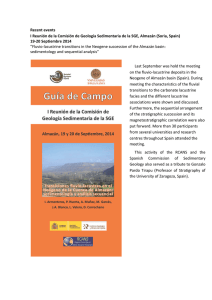Geology and hydrocarbon potential in offshore Uruguay
Anuncio
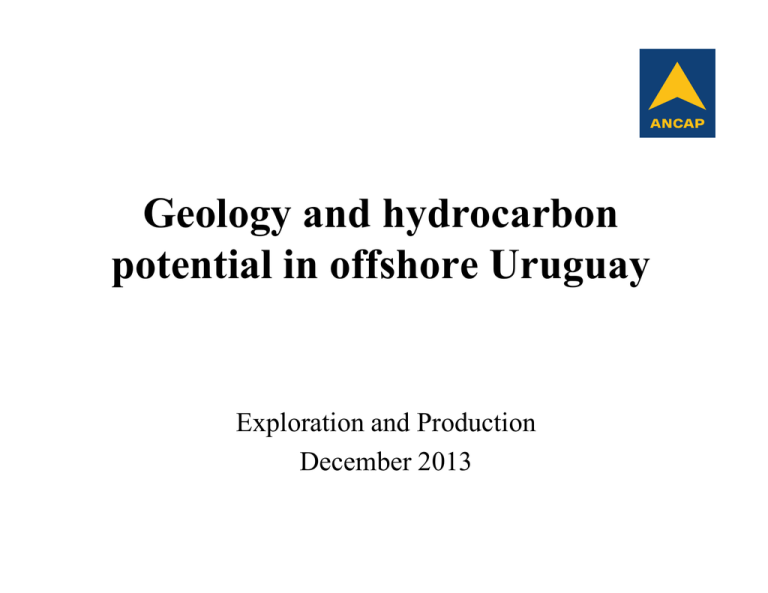
Geology and hydrocarbon potential in offshore Uruguay Exploration and Production December 2013 CONTENTS • • • • Offshore basins from Uruguay Geological setting Database and methodology Continental margin of Uruguay – – – – Crustal structure Stratigraphic analysis Depositional sequences Petroleum systems CONTENTS • • • • Offshore basins from Uruguay Geological setting Database and methodology Continental margin of Uruguay – – – – Crustal structure Stratigraphic analysis Depositional sequences Petroleum systems CONTENTS • • • • Offshore basins from Uruguay Geological setting Database and methodology Continental margin of Uruguay – – – – Crustal structure Stratigraphic analysis Depositional sequences Petroleum systems South Atlantic basins Mohriak et al. (2002). Volcanic rifted margin Geoffroy (2005) Southwestern Atlantic basin evolution Modificado de Paton et al. (2007), Winter et al. (2007), Pereira e Feijó (1994), Dias et al. (1994). Petroleum systems of South Atlantic basins Berlinger et al. 2013. CONTENTS • • • • Offshore basins from Uruguay Geological setting Database and methodology Continental margin of Uruguay – – – – Crustal structure Stratigraphic analysis Depositional sequences Petroleum systems 2D SEISMIC – ALL CAMPAINGS ANCAP 2D SEISMIC – VINTAGE DATA ANCAP 2D SEISMIC - 2011 SPECTRUM MULTICLIENT 2D SEISMIC (2007 AND 2008) SPECTRUM MULTICLIENT 2D SEISMIC (2002, 2013 AND 2014) ION GXT MULTICLIENT 2D SEISMIC (2012) 3D SEISMIC GRAV & MAG COVERAGE WELLS Methodology Crustal structure Seismic interpretation (seismostratigraphy) PETROLEUM SYSTEM Thermal modeling Gravity modeling CONTENTS • • • • Offshore basins from Uruguay Geological setting Database and methodology Continental margin of Uruguay – – – – Crustal structure Stratigraphic analysis Depositional sequences Petroleum systems Crustal structure Bathymetry TMI Free-aire gravity Bouguer gravity anomaly Gravity modeling Southern segment Central segment Northern segment CONTENTS • • • • Offshore basins from Uruguay Geological setting Database and methodology Continental margin of Uruguay – – – – Crustal structure Stratigraphic analysis Depositional sequences Petroleum systems Mapped horizons Nº Horizon Age Criteria H.1. Basement top Precambrian Tope del basamento cristalino H.2. Synrift base Jurassic-Lower Cretaceous Tope de las rocas sedimentarias del prerift y em el tope del basamento cristalino H.3. Synrift top Diachronic surface Lower Cretaceous Abajo: truncamientos Arriba: Ol y Dl H.4. Transition top Lower Cretaceous (probably Barremian-Aptian) Abajo: truncamientos Arriba: Ol en los sectores proximales y Dl em los sectores distales H.5. Postrift Seq. 1 top Lower Cretaceous (probably Aptian) En el tope de un paquete sísmico homogéneo, con reflectores en Ol hacia el continente H.6. Postrift Seq. 2 top Lower Cretaceous (probably Albian) Abajo: truncamientos Arriba: Ol en los sectores proximales y Dl em los sectores distales H.7. Postrift Seq. 3 top Lower Cretaceous Abajo: truncamientos Arriba: Ol en los sectores proximales y Dl em los sectores distales H.8. Postrift Seq. 4 top Uppermost Cretaceous Abajo: truncamientos Arriba: Ol en el talud H.9. Postrift Seq. 5 top Uppermost Paleocene Abajo: truncamientos Arriba: Ol en los sectores distales H.10. Postrift Seq. 6 top Middle Eocene Abajo: truncamientos H.11. Postrift Seq. 7 top Eocene Abajo: truncamientos Arriba: Ol H.12. Postrift Seq. 8 top Lower Miocene Abajo: truncamientos Arriba: Dl en la plataforma H.13. Postrift Seq. 9 top Oligocene-Miocene Abajo: truncamientos Arriba: Ol en el talud H.14. Postrift Seq. 10 top Miiddle Miocene Arriba: Dl en la plataforma y Ol en el talud H.15. Postrift Seq. 11 top Recent Fondo del mar Depositional sequences •Secuencia Prerift (H.1): Paleozoico •Secuencia Rift (H.2): Jurásico – Cretácico Inferior •Secuencia de Transición (H.3): Cretácico Inferior (Probablemente Barremiano-Aptiano). •Secuencia Postrift 1 (H.3): Cretácico Inferior (Probablemente Aptiano). •Secuencia Postrift 2 (H.4/H.5): Cretácico Inferior (Probablemente Albiano). •Secuencia Postrift 3 (H.6): Cretácico Superior. •Secuencia Postrift 4 (H.7): Cretácico Superior (Maastrichtiano). •Secuencia Postrift 5 (H.8): Paleoceno. •Secuencia Postrift 6 (H.9): Eoceno Medio. •Secuencia Postrift 7 (H.10): Eoceno. •Secuencia Postrift 8 (H.11): Oligoceno Inferior. •Secuencia Postrift 9 (H.12): Oligoceno Superior. •Secuencia Postrift 10 (H.13): Mioceno Inferior – Médio. •Secuencia Postrift 11 (H.14): Mioceno Superior – Reciente Strike seismic sections across the Uruguay continental margin Deep waters Shallow waters PUNTA DEL ESTE BASIN PELOTAS BASIN PUNTA DEL ESTE BASIN PELOTAS BASIN Polonio High Flat-lying flows Dip seismic section across the Punta del Este Basin Dip seismic section across the Pelotas Basin Dip seismic section across the Pelotas Basin Structural contour map of seabed Structural contour map of synrift base Structural contour map of transition top Structural contour map of basament top Rift sequence isopach map Cretaceous postrift isopach map Transition sequence isopach map Cenozoic postrift isopach map Depocenter migration B B Stratigraphic charts Punta del Este Basin Pelotas Basin CONTENTS • • • • Offshore basins from Uruguay Geological setting Database Continental margin of Uruguay – – – – Crustal structure Stratigraphic analysis Depositional sequences Petroleum systems Petroleum systems • Sistemas petrolíferos 50º C 175º C Cross-section through Uruguayan basins South Atlantic basins Source rocks AFRICA SOUTH AMERICA Espirito Santo 9% COT Neoc-Barr (L) Congo 20% COT Neoc-Barr (L) 4% COT Ap/Alb (M) < 1% COT Late K-Ter (M) Kwanza 20% COT Neoc-Barr (L) Campos 9% COT Neoc-Barr (L) Santos 6% COT Neoc-Barr (L) 3 % COT Cen –Tur (M) Namibia 10% COT Cen-Tur (M) Walvis 5% COT Cen-Tur (M) Pelotas: Tur 3% COT (M) Colorado 2,4 % COT Neoc-Barr (M) 3,4 % TOC Pérmico (M) San 3% COT Jur Tardío (L) Jorge 3% COT Ap/Alb (L) Malvinas Norte Austral 1.6 - 6% COT Jur Tardío (L) 3% COT Neoc-Barr (L) 7.3% COT (L) 6% TOC (M) Jur Tardío. 2% COT Neoc-Barr (M) Orange 10% COT Neoc-Barr (L) 3,8% COT Ap/Ab (M) DSDP Pozo 361 15% COT Ap/Ab (L) Depositional environment (L) – Lacustrine (M) – Marine Arbitrary lines showing development of Aptian sequence Punta del Este Basin Pelotas Basin Polonio High Aptian sequence Potential source rocks Sequence Age OM type TOC (%) Prerift Permian I 8 Synrift Neocomian I 3 Postrift 1 Aptian I 5 Postrift 3 CenomanianTuronian II 4 Paleocene Oligocene Present day Source rock maturity Maturity map of prerift sequence (present day) Maturity map of prerift sequence (uppermost Oligocene) Maturity map of prerift sequence (uppermost Paleocene) Maturity map of synrift sequence (present day) Maturity map of synrift sequence (uppermost Oligocene) Maturity map of synrift sequence (uppermost Paleocene) Maturity windows Oil (Ro% 0.6-1.3) Oil generation peak (Ro% 0.9-1.0) Condensate and wet gas (Ro% 1,3-2.0) Dry gas (Ro% >2.0) Source rock maturity Maturity map of Aptian sequence (present day) Maturity map of Aptian sequence (uppermost Oligocene) Maturity map of Aptian sequence (uppermost Paleocene) Maturity map of Cen-Tur sequence (present day) Maturity map of Cen-Tur sequence (uppermost Oligocene) Maturity map of Cen-Tur sequence (uppermost Paleocene) Maturity windows Oil (Ro% 0.6-1.3) Oil generation peak (Ro% 0.9-1.0) Condensate and wet gas (Ro% 1,3-2.0) Dry gas (Ro% >2.0) POTENTIAL ANALOGUES A. Shallow marine reservoirs: Carrot Creek Alpine Edvard Grieg (formerly Luno) B. Deep marine reservoirs: Albacora Roncador Marlim Source rock: Lagoa Feia Fm. Reservoir rock: Carapebus Fm. Fine to medium-grained sandstones, medium to coarse-grained sandstones; diamictites and conglomerates. Porosity of 17-30% Oilfield is segmented by faults in several block Oil: 17 to 31º API RONCADOR • • • • Discovered in 1996 Bathymetry: 1500-200 m, distance to the coast: 130 km, area: 115 km2 Offshore Brazil (Campos Basin) Reserves: 2.900 mmbo Source rock: Lagoa Feia Fm. Reservoir rock: Carapebus Fm. Fine to medium-grained sandstones, of up to 250 m packages Porosity of 27-30% Trap: Albian to Miocene turbidites Oil: 18 to 31º API MARLIM • • • • Discovered in 1985 Bathymetry: 500-1.100 m, distance to the coast: ?? km, area: 150 km2 Offshore Brazil (Campos Basin) Reserves: 1.700 mmbo Source rock: Lagoa Feia Fm. Reservoir rock: Carapebus Fm. Fine to medium-grained massive sandstones Bioturbated, interbedded sandstones-pelites Very fine-grained sandstones with ripples Reservoir of 47 m mean thickness and 25% porosity Trap: coalescing, unconfined low-stand fans of Oligocene age Oil: 17 to 21º API UPDATE ON ONSHORE SOURCE ROCKS AND OFFSHORE PETROLEUM SYSTEMS Onshore Uruguay – source rocks Castellanos Fm. (Santa Lucía Basin) TOC: up to 2,9% IH: up to 400 mg HC/g COT Types II and III kerogen Castellanos Mangrullo San Gregorio Cordobés NORTE BASIN Mangrullo Fm. TOC: up to 13,5% HI: up to 1000 mg HC/g COT Type I kerogen San Gregorio Fm. TOC: up to 13% IH: hasta 400 mg HC/g COT Type II kerogen NORTE BASIN Cordobés Fm. TOC: up to 4% IH: up to 400 mg HC/g COT Type II kerogen 2 cm Marine petroleum system of prerift stage (?) Lacustrine petroleum system of synrift stage (?) Marine petroleum system of Cretaceous postrift stage (?) Marine petroleum system of Cenozoic postrift stage (?) Unconventional petroleum system related to gas hydrates (?) NEW IDEAS ON OFFSHORE BASINS 1. Possible carbonates 2. SDR composition (sediments >> volcanics) 3. High velocity lower crust 4. Igneous centers 5. New evidences on the Río de la Plata Transfer System 6. Continuity of ultradeep-water depocenters 7. Basin thickness and crustal thickness 8. Sedimentary processes on continental slope 1. POSSIBLE CARBONATES Anticline with 4 way closure Carbonates protected from clastic dilution due to updip high 2. SDR COMPOSITION (SEDIMENTS >> VOLCANICS) 3. HIGH VELOCITY LOWER CRUST IGNEOUS CENTERS 5. NEW EVIDENCES ON THE TRANSFER SYSTEM 2 4 6 Basin infill RPTS 8 10 12 14 Strechted continental crust 16 18 20 Upper mantle 6. CONTINUITY OF ULTRADEEP‐WATER DEPOCENTERS 7. BASIN THICKNESS AND CRUSTAL THICKNESS Basin thickness (km) Crustal thickness (km) 8. SEDIMENTARY PROCESSES ON CONTINENTAL SLOPE shallower to deeper depths) along the slope. THANK YOU VERY MUCH!
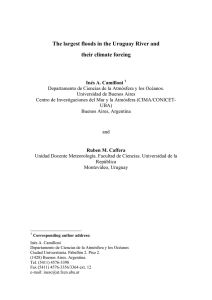
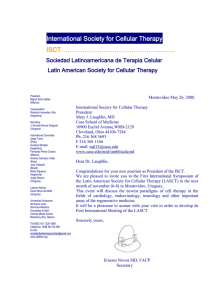

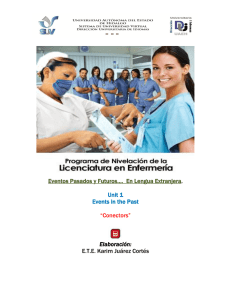

![nord-ctc-8 [Converted].cdr](http://s2.studylib.es/store/data/005153308_1-47a6f3805c7837d1595a567267de83e2-300x300.png)
![Presentacion Chile - Canada [Modo de compatibilidad]](http://s2.studylib.es/store/data/006031439_1-d894d5d2d359230b5c2007cc916df922-300x300.png)

